3D Microstructure Simulation of Reactive Aggregate in Concrete from 2D Images as the Basis for ASR Simulation
Abstract
:1. Introduction
2. Research Significance
3. Material and Experimental Methods
3.1. Materials
3.2. Methods
3.2.1. Optical Petrography
3.2.2. Scanning Electron Microscope
3.2.3. X-ray Diffraction
3.2.4. Mercury Intrusion Porosimetry
4. Framework Development of 3D Microstructure Simulation
4.1. Thin Section Petrography and the 2D Microstructure Features from SEM-BSE
4.2. Thresholding & Binarization
4.3. 3D Simulation
4.3.1. Representative Image Selection
- Firstly, the normalized histograms of pore fraction and the quartz fraction from all of the 90 binarized images were drawn as shown in Figure 8. In Figure 8, the fraction distribution is divided into 10 bins represented by the blue bar. The x-axis is the pore or quartz fraction. The y-axis represents the probability distribution of the pore or quartz fraction within 90 binarized images.
- Based on the histogram, the lognormal distributions were fitted for the pore and quartz fractions, respectively. Equation (1) is the lognormal probability density function.where X is the pore or quartz fraction, and P is the probability density at fraction X. is the mean value and is the standard deviation. These are the mean value and standard deviation of the variable’s natural logarithm, not the expectation and standard deviation of X itself. and can be calculated through mean(ln(X)) and std(ln(X)), respectively. The fitted () based on the data from 90 images for pore and quartz are (1.20, 0.50) and (2.70, 0.52), respectively. The functions are drawn in Figure 8 by a black curve.Three representative statistical variables (the mode, the mean, and the median with their definition shown below Table 2) of the pore and quartz fraction calculated from the fitted lognormal distribution and images are shown in Table 2. The differences of these variables of pore fractions between the fitted curve and original data from 2D images are very small, except the mode pore fraction of the fitted curve is around 1% lower than the original one. The differences of these variables of quartz fraction between the fitted curve and raw data are also small, mainly below 2%, except that the median quartz fraction of the fitted curve is 4% higher than that of the original data. Generally speaking, the fitted lognormal distribution of the pore and quartz fraction can represent the true distributions pore and quartz fractions in the selected 90 images.
- Finally, representative fractions were selected through the probability density function curve. In total, 10 representative images were selected: Five images with quartz fractions of (6.58%, 10.44%, 20.68%, 32.58%, 41.23%) and another five images with a pore fractions of (0.66%, 2.18%, 3.26%, 4.3%, and 8.0%) as indicated by the x-axis values of the red solid circles in Figure 8a,b, respectively. These five fractions are representative not only because they cover the whole fraction distribution span of silica or pores, but also capture the main characteristics of the fraction distribution, such as the global maximum fraction value.
4.3.2. Simulation Method
5. Experimental Corroboration of the Simulated 3D Microstructure
5.1. Visual Checking
5.2. Numerical Checking
5.3. Quartz Fraction from Model and XRD
5.3.1. Quantitative Results from XRD
5.3.2. Upscale from Microscale to Mesoscale
5.3.3. Quartz Fraction Comparison
5.4. Pore Fraction from Model, SEM and MIP
6. Application of the Model
7. Conclusions
- (1).
- Suitable experimental methods should be chosen to obtain 2D images of the aggregate with a clear outline between particles, considering the particle sizes of the target phase, and suitable binarization methods should be chosen to segment the target phase from the images.
- (2).
- The pore and silica fraction distributions on the 2D SEM-BSE images of the limestone can be fitted by a lognormal distribution, which can be used to select representative images for 3D microstructure simulations.
- (3).
- The simulated microstructures of the siliceous limestone are able to retain the visual characteristics, such as the particle shape and spatial scattering, as well as the statistical characteristics of the air void and quartz silica, such as the fraction, characteristic particle size, and the specific surface area of the parent limestone. However, the pore information below the simulation voxel size (1 m) is lost during the simulation.
- (4).
- The simulated microstructures can be used to assemble the aggregate at a mesoscale embedded in mortar following the obtained lognormal distribution. The average air void and silica fraction show good consistency with the XRD and MIP results.
Author Contributions
Funding
Institutional Review Board Statement
Informed Consent Statement
Data Availability Statement
Acknowledgments
Conflicts of Interest
References
- Silva, F.A.; Delgado, J.M.; Azevedo, A.C.; Mahfoud, T.; Khelidj, A.; Nascimento, N.; Lima, A.G. Diagnosis and Assessment of Deep Pile Cap Foundation of a Tall Building Affected by Internal Expansion Reactions. Buildings 2021, 11, 104. [Google Scholar] [CrossRef]
- Delgado, J.; Nascimento, N.; Silva, F.; Azevedo, A. Diagnostic of concrete samples of pile caps affected by internal swelling reactions. Iran. J. Sci. Technol. Trans. Civ. Eng. 2021, 1–13. [Google Scholar] [CrossRef]
- Silva, F.; Delgado, J.; Azevedo, A.; Lira, I. Numerical Analysis of Bottle-Shaped Isolated Struts Concrete Deteriorated by Delayed Ettringite Formation. Iran. J. Sci. Technol. Trans. Civ. Eng. 2021, 1–16. [Google Scholar] [CrossRef]
- Stanton, T.E. Expansion of concrete through reaction between cement and aggregate. Trans. Am. Soc. Civ. Eng. 1942, 107, 54–84. [Google Scholar] [CrossRef]
- Rajabipour, F.; Giannini, E.; Dunant, C.; Ideker, J.H.; Thomas, M.D. Alkali–silica reaction: Current understanding of the reaction mechanisms and the knowledge gaps. Cem. Concr. Res. 2015, 76, 130–146. [Google Scholar] [CrossRef]
- Ponce, J.; Batic, O.R. Different manifestations of the alkali-silica reaction in concrete according to the reaction kinetics of the reactive aggregate. Cem. Concr. Res. 2006, 36, 1148–1156. [Google Scholar] [CrossRef]
- Leemann, A.; Münch, B. The addition of caesium to concrete with alkali-silica reaction: Implications on product identification and recognition of the reaction sequence. Cem. Concr. Res. 2019, 120, 27–35. [Google Scholar] [CrossRef]
- Sanchez, L.; Fournier, B.; Jolin, M.; Duchesne, J. Reliable quantification of AAR damage through assessment of the damage rating index (DRI). Cem. Concr. Res. 2015, 67, 74–92. [Google Scholar] [CrossRef]
- Shin, J.H.; Struble, L.J.; Kirkpatrick, R.J. Microstructural changes due to alkali-silica reaction during standard mortar test. Materials 2015, 8, 8292–8303. [Google Scholar] [CrossRef] [Green Version]
- Bažant, Z.P.; Steffens, A. Mathematical model for kinetics of alkali–silica reaction in concrete. Cem. Concr. Res. 2000, 30, 419–428. [Google Scholar] [CrossRef] [Green Version]
- Dunant, C.F.; Scrivener, K.L. Micro–mechanical modelling of alkali–silica–reaction–induced degradation using the AMIE framework. Cem. Concr. Res. 2010, 40, 517–525. [Google Scholar] [CrossRef]
- Çopuroğlu, O.; Schlangen, E. Modelling of effect of ASR on concrete microstructure. Key Eng. Mater. 2007, 348, 809–812. [Google Scholar] [CrossRef]
- Miura, T.; Multon, S.; Kawabata, Y. Influence of the distribution of expansive sites in aggregates on microscopic damage caused by alkali-silica reaction: Insights into the mechanical origin of expansion. Cem. Concr. Res. 2021, 142, 106355. [Google Scholar] [CrossRef]
- Cnudde, V.; Boone, M.N. High-resolution X-ray computed tomography in geosciences: A review of the current technology and applications. Earth-Sci. Rev. 2013, 123, 1–17. [Google Scholar] [CrossRef] [Green Version]
- Fernandes, J.S.; Appoloni, C.R.; Fernandes, C.P. Determination of the representative elementary volume for the study of sandstones and siltstones by X-ray microtomography. Mater. Res. 2012, 15, 662–670. [Google Scholar] [CrossRef] [Green Version]
- De Boever, W.; Derluyn, H.; Van Loo, D.; Van Hoorebeke, L.; Cnudde, V. Data-fusion of high resolution X-ray CT, SEM and EDS for 3D and pseudo-3D chemical and structural characterization of sandstone. Micron 2015, 74, 15–21. [Google Scholar] [CrossRef] [Green Version]
- Bostanabad, R.; Zhang, Y.; Li, X.; Kearney, T.; Brinson, L.C.; Apley, D.W.; Liu, W.K.; Chen, W. Computational microstructure characterization and reconstruction: Review of the state-of-the-art techniques. Prog. Mater. Sci. 2018, 95, 1–41. [Google Scholar] [CrossRef]
- Wu, W.; Jiang, F. Simulated annealing reconstruction and characterization of the three-dimensional microstructure of a LiCoO2 lithium-ion battery cathode. Mater. Charact. 2013, 80, 62–68. [Google Scholar] [CrossRef]
- Kim, S.Y.; Kim, J.S.; Lee, J.H.; Kim, J.H.; Han, T.S. Comparison of microstructure characterization methods by two-point correlation functions and reconstruction of 3D microstructures using 2D TEM images with high degree of phase clustering. Mater. Charact. 2021, 172, 110876. [Google Scholar] [CrossRef]
- Sumanasooriya, M.S.; Bentz, D.P.; Neithalath, N. Planar image-based reconstruction of pervious concrete pore structure and permeability prediction. ACI Mater. J. 2010, 107, 413–421. [Google Scholar]
- Yu, F.; Sun, D.; Hu, M.; Wang, J. Study on the pores characteristics and permeability simulation of pervious concrete based on 2D/3D CT images. Constr. Build. Mater. 2019, 200, 687–702. [Google Scholar] [CrossRef]
- Bentz, D.P. Three-dimensional computer simulation of Portland cement hydration and microstructure development. J. Am. Ceram. Soc. 1997, 80, 3–21. [Google Scholar] [CrossRef]
- De Schutter, G. The detrimental power of alkali silica reaction: Remarkable case study. In Proceedings of the Concrete under Severe Conditions: Environment and Loading (CONSEC-2013), Nanjing, China, 23–25 September 2013. [Google Scholar]
- Andreola, F.; Leonelli, C.; Romagnoli, M. Techniques Used to Determine Porosity. Am. Ceram. Soc. Bull. 2000, 79, 49–52. [Google Scholar]
- BS EN 1097-6:2000, Tests for Mechanical and Physical Properties of Aggregates, Determination of Particle Density and Water Absorption; British Standards Institution: London, UK, 2000.
- BS EN 932-1:1997, Tests for General Properties of Aggregates, Methods for Sampling; Part 1; British Standards Institution: London, UK, 1997.
- BS EN 932-2:1999, Tests for General Properties of Aggregates, Methods for Reducing Laboratory Samples; Part 2; British Standards Institution: London, UK, 1999.
- Beaucour, A.L.; Hebert, R.; Noumowé, A.; Ledésert, B.; Bodet, R. Thermal stability of different siliceous and calcareous aggregates subjected to high temperature. In Proceedings of the MATEC Web of Conferences 6, Paris, France, 25–27 September 2013. [Google Scholar]
- Razafinjato, R.N.; Beaucour, A.L.; Hebert, R.L.; Ledesert, B.; Bodet, R.; Noumowe, A. High temperature behaviour of a wide petrographic range of siliceous and calcareous aggregates for concretes. Constr. Build. Mater. 2016, 123, 261–273. [Google Scholar] [CrossRef]
- Washburn, E.W. Note on a method of determining the distribution of pore sizes in a porous material. Proc. Natl. Acad. Sci. USA 1921, 7, 115. [Google Scholar] [CrossRef] [Green Version]
- MacKenzie, W.S.; Adams, A.E.; Brodie, K.H. Rocks and Minerals in Thin Section: A Colour Atlas; CRC Press: Boca Raton, FL, USA, 2017. [Google Scholar]
- Fernandes, I.; dos Anjos Ribeiro, M.; Broekmans, M.A.; Sims, I. Petrographic Atlas: Characterisation of Aggregates Regarding Potential Reactivity to Alkalis: RILEM TC 219-ACS Recommended Guidance AAR-1.2, for Use with the RILEM AAR-1.1 Petrographic Examination Method; Springer: Berlin, Germany, 2016. [Google Scholar]
- Scrivener, K.L.; Pratt, P. Backscattered electron images of polished cement sections in the scanning electron microscope. In Proceedings of the 6th International Conference on Cement Microscopy, Albuquerque, NM, USA, 26–29 March 1984. [Google Scholar]
- Hu, C.; Li, Z. Property investigation of individual phases in cementitious composites containing silica fume and fly ash. Cem. Concr. Compos. 2015, 57, 17–26. [Google Scholar] [CrossRef]
- Edwin, R.S.; Mushthofa, M.; Gruyaert, E.; De Belie, N. Quantitative analysis on porosity of reactive powder concrete based on automated analysis of back-scattered-electron images. Cem. Concr. Compos. 2019, 96, 1–10. [Google Scholar] [CrossRef]
- Sahu, S.; Badger, S.; Thaulow, N.; Lee, R. Determination of water–cement ratio of hardened concrete by scanning electron microscopy. Cem. Concr. Compos. 2004, 26, 987–992. [Google Scholar] [CrossRef]
- Russ, J.C.; Dehoff, R.T. Practical Stereology; Springer Science & Business Media: Berlin, Germany, 2012. [Google Scholar]
- Lim, J.S. Two-Dimensional Signal and Image Processing; Pearson Education: London, UK, 1989. [Google Scholar]
- Kim, H.; Ahn, E.; Cho, S.; Shin, M.; Sim, S.H. Comparative analysis of image binarization methods for crack identification in concrete structures. Cem. Concr. Res. 2017, 99, 53–61. [Google Scholar] [CrossRef]
- Wong, H.S.; Head, M.K.; Buenfeld, N.R. Pore segmentation of cement-based materials from backscattered electron images. Cem. Concr. Res. 2006, 36, 1083–1090. [Google Scholar] [CrossRef] [Green Version]
- Otsu, N. A threshold selection method from gray-level histograms. IEEE Trans. Syst. Man Cybern. 1979, 9, 62–66. [Google Scholar] [CrossRef] [Green Version]
- Keys, R. Cubic convolution interpolation for digital image processing. IEEE Trans. Acoust. Speech Signal Process. 1981, 29, 1153–1160. [Google Scholar] [CrossRef] [Green Version]
- Sahoo, K.; Dhir, P.K.; Teja, P.R.R.; Sarkar, P.; Davis, R. Variability of silica fume concrete and its effect on seismic safety of reinforced concrete buildings. J. Mater. Civ. Eng. 2020, 32, 04020024. [Google Scholar] [CrossRef] [Green Version]
- Quiblier, J.A. A new three-dimensional modeling technique for studying porous media. J. Colloid Interface Sci. 1984, 98, 84–102. [Google Scholar] [CrossRef]
- Berryman, J.G. Measurement of spatial correlation functions using image processing techniques. J. Appl. Phys. 1985, 57, 2374–2384. [Google Scholar] [CrossRef]
- Berryman, J.G.; Blair, S.C. Kozeny–Carman relations and image processing methods for estimating Darcy’s constant. J. Appl. Phys. 1987, 62, 2221–2228. [Google Scholar] [CrossRef]
- Anthony, J.W. Handbook of Mineralogy; Mineral Data Publishing: Tuscon, AZ, USA, 1990. [Google Scholar]
- Kim, J.J.; Fan, T.; Reda Taha, M.M. A homogenization approach for uncertainty quantification of deflection in reinforced concrete beams considering microstructural variability. Struct. Eng. Mech. 2011, 38, 503. [Google Scholar] [CrossRef]
- Garboczi, E.J.; Bentz, D.P. Computer simulation and percolation theory applied to concrete. In Annual Reviews of Computational Physics VII; World Scientific: Singapore, 1999; Volume 85. [Google Scholar]
- Qian, Z.W. Multiscale Modeling of Fracture Processes in Cementitious Materials. Ph.D. Thesis, Delft University of Technology, Delft, The Netherlands, 2012. [Google Scholar]
- Qiu, X.; Chen, J.; Schlangen, E.; Ye, G.; De Schutter, G. Introduction of a multi-scale chemo-physical simulation model of ASR. In Proceedings of the 15th International Congress on the Chemistry of Cement (ICCC), Prague, Czech Republic, 16–20 September 2019. [Google Scholar]

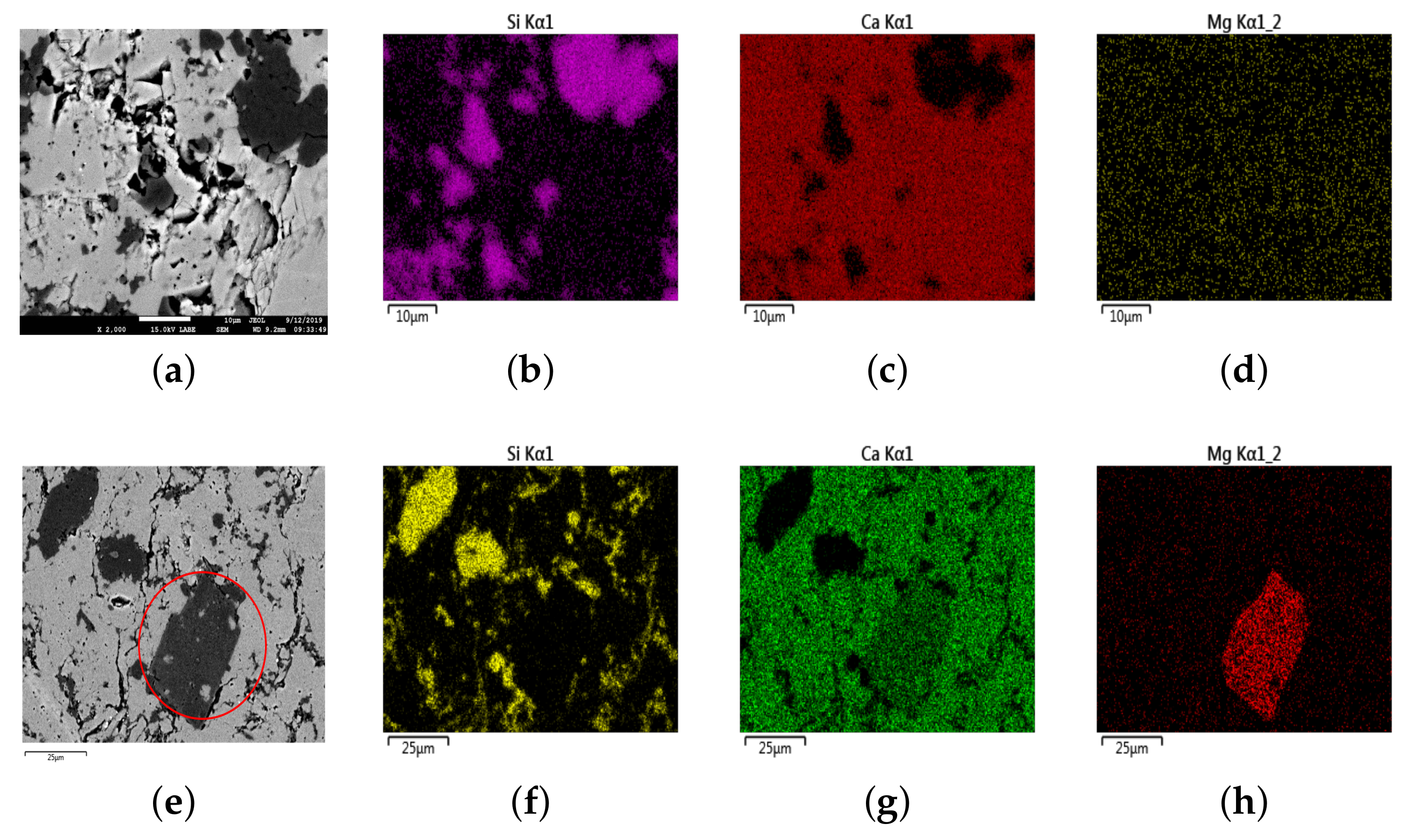
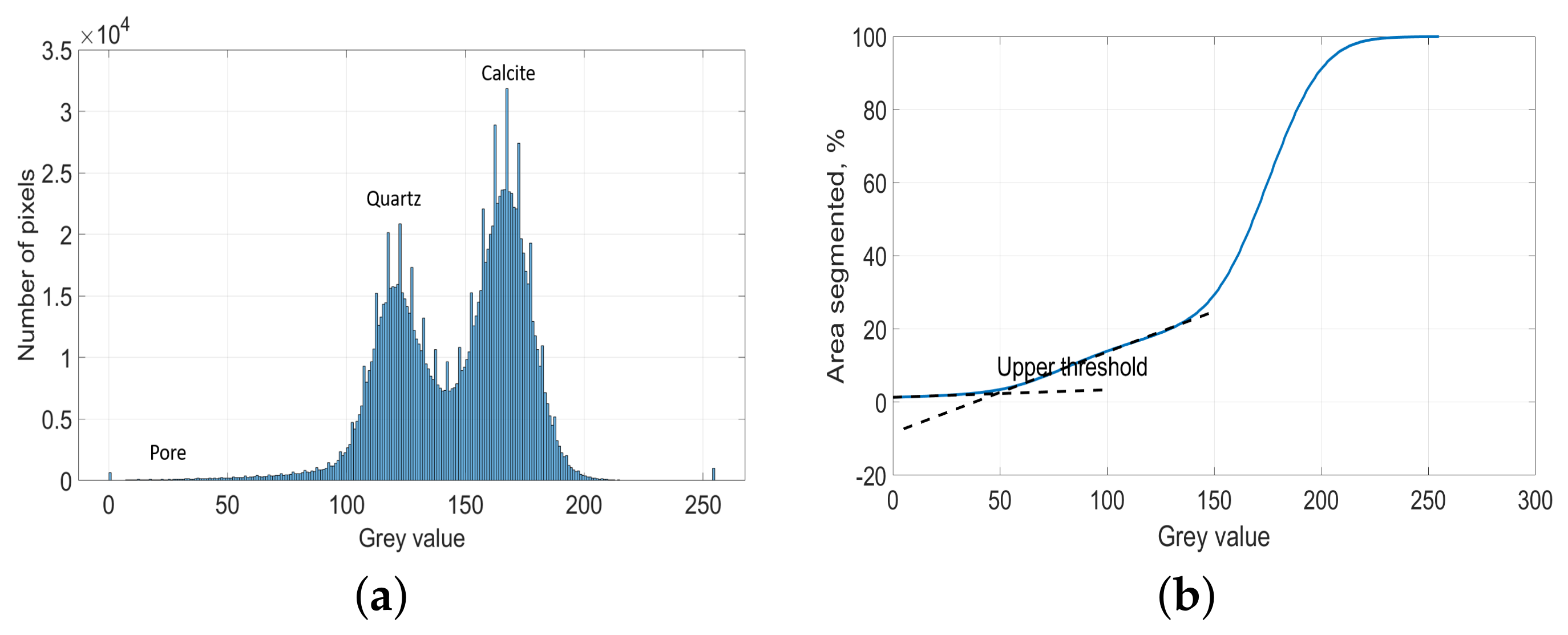
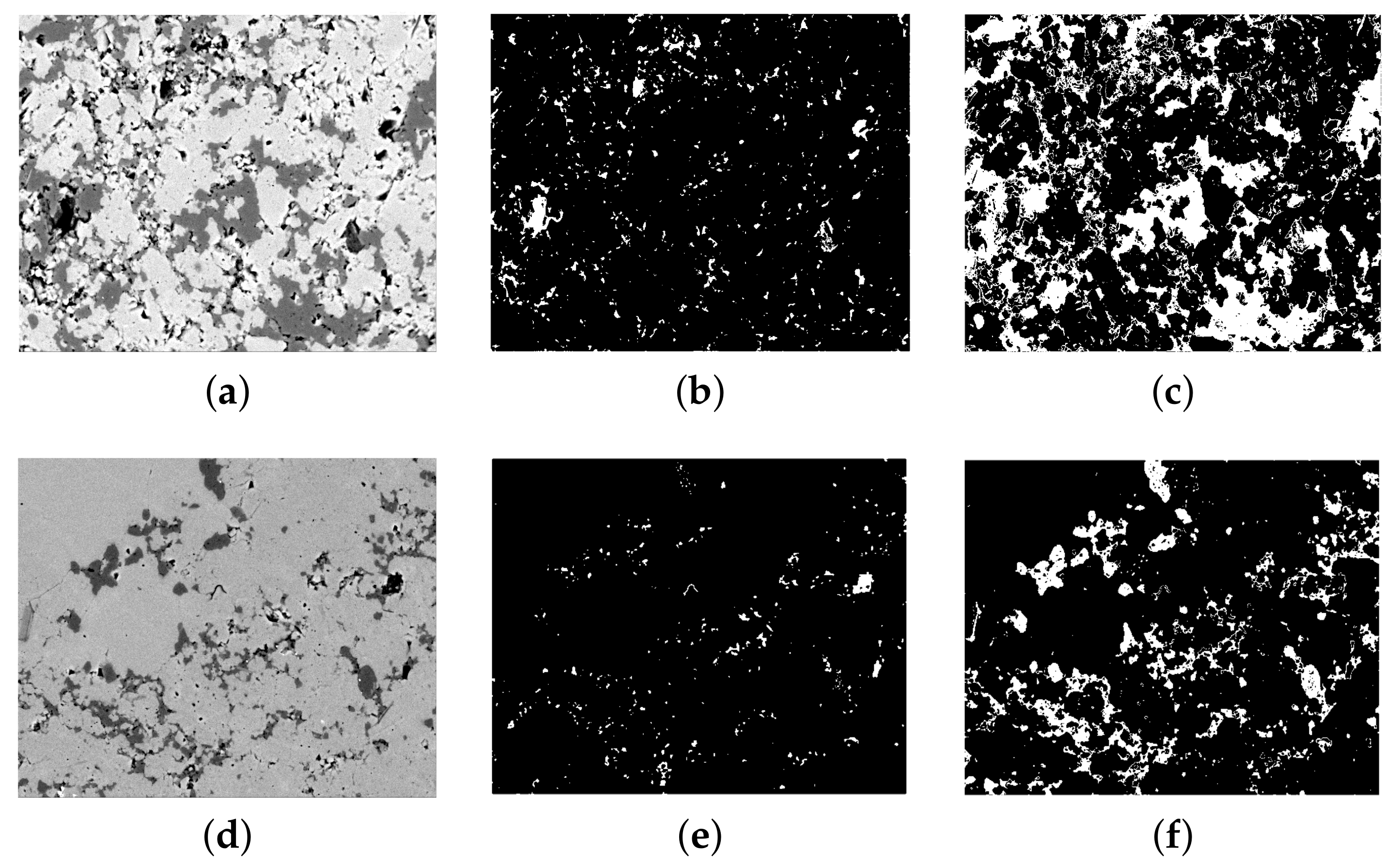
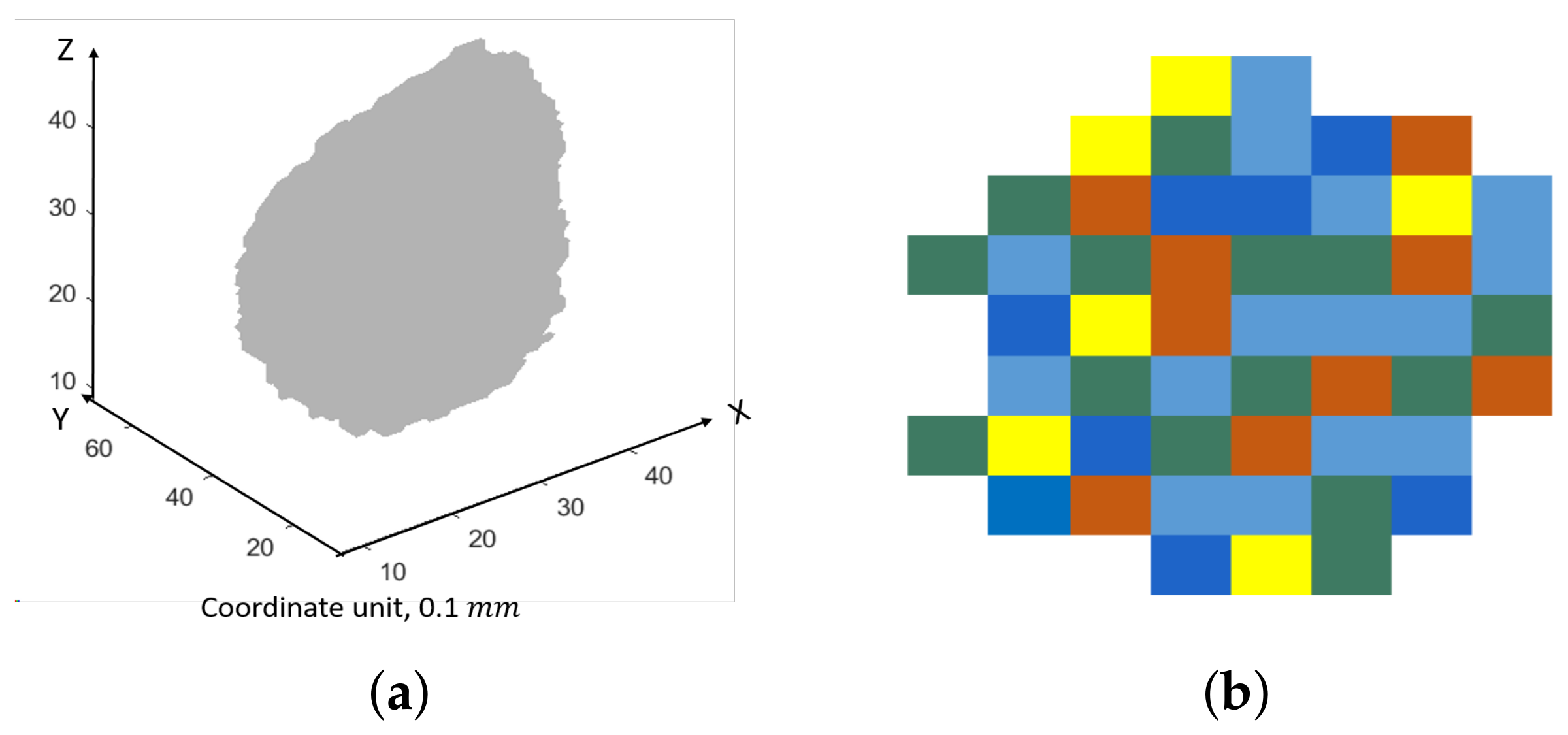

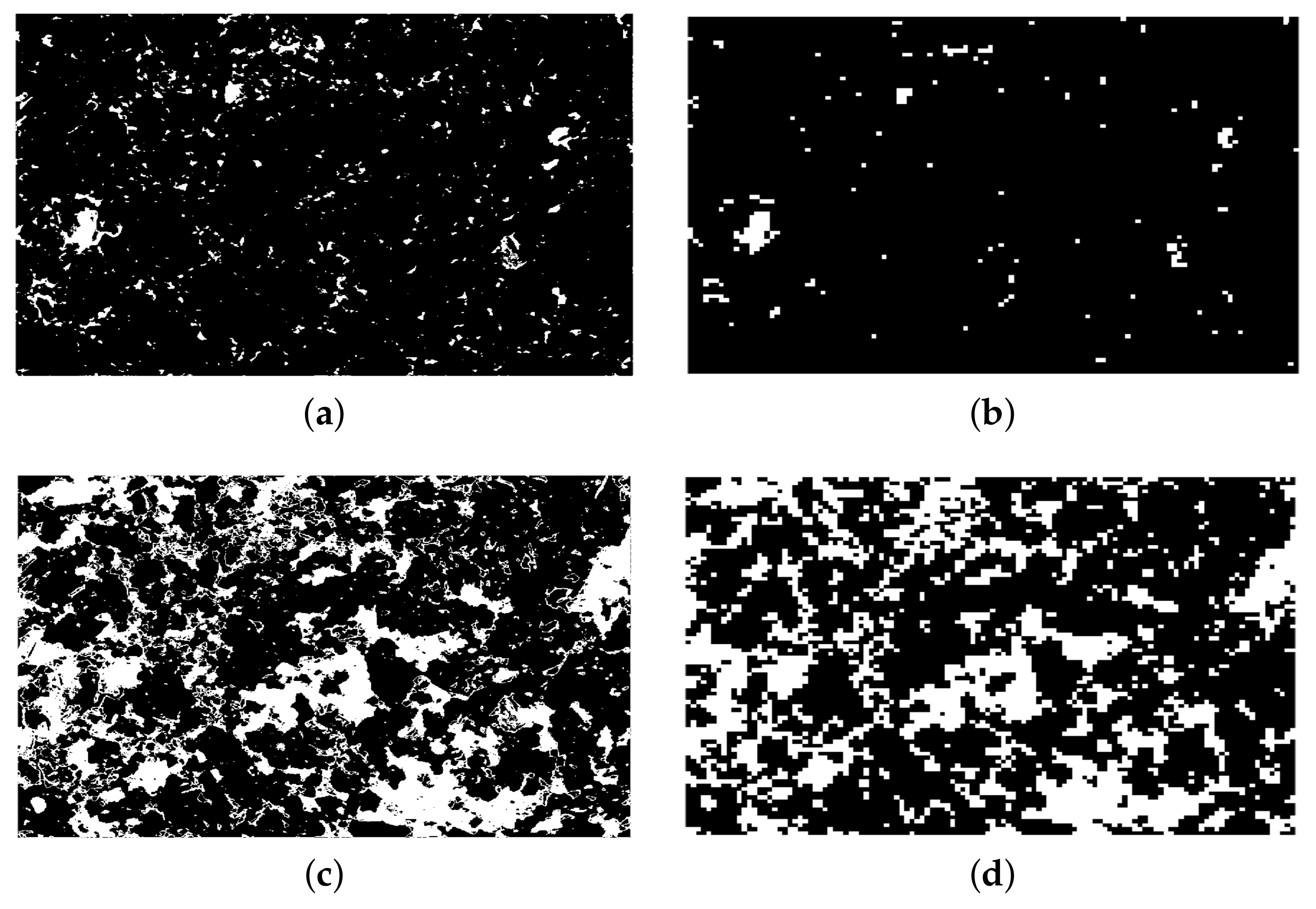
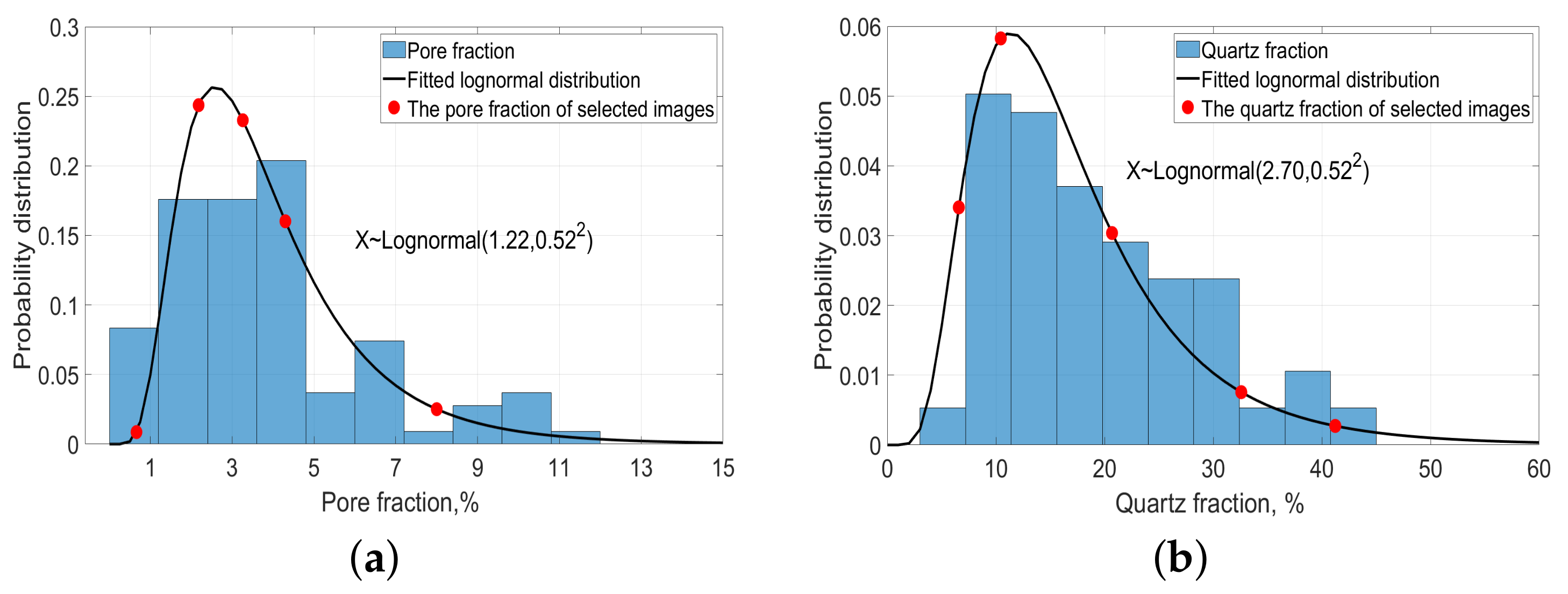
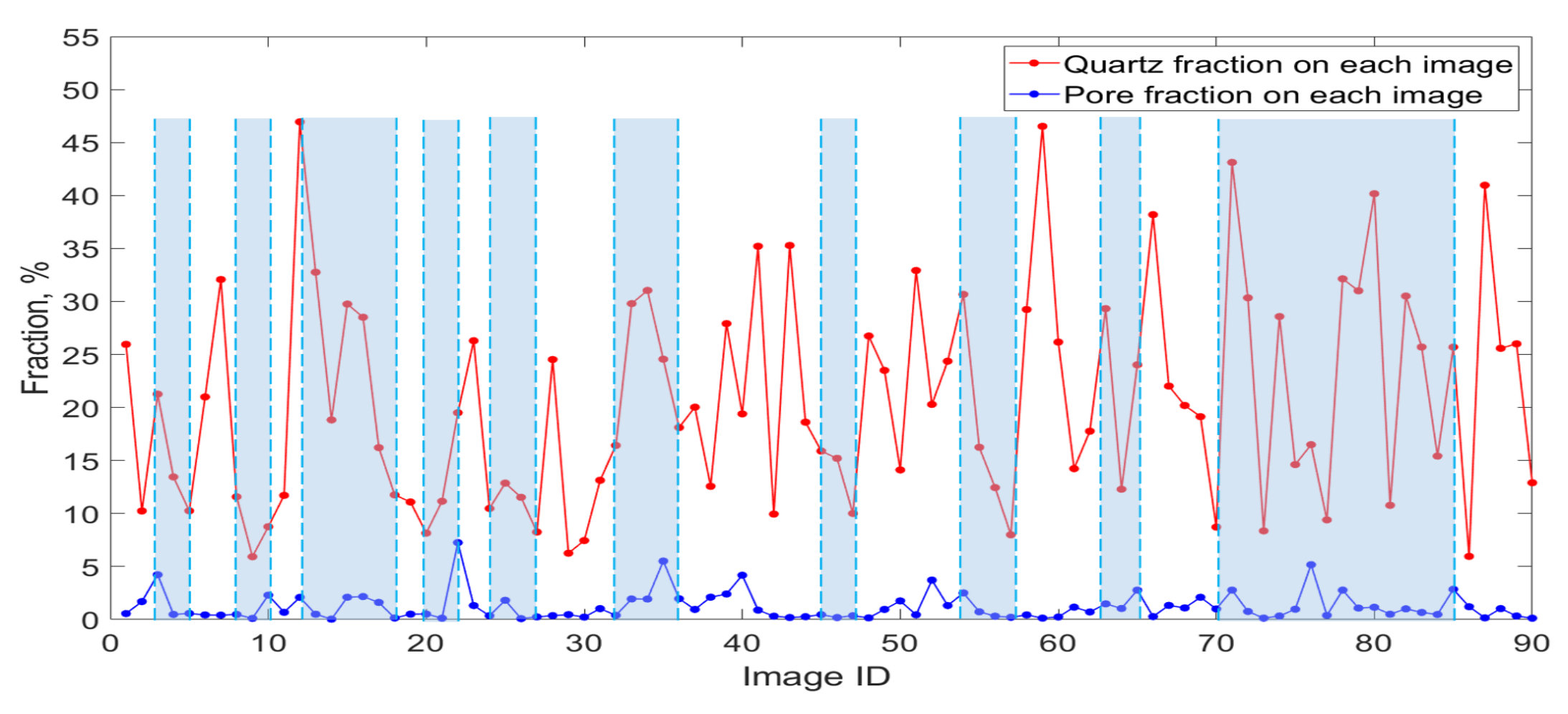
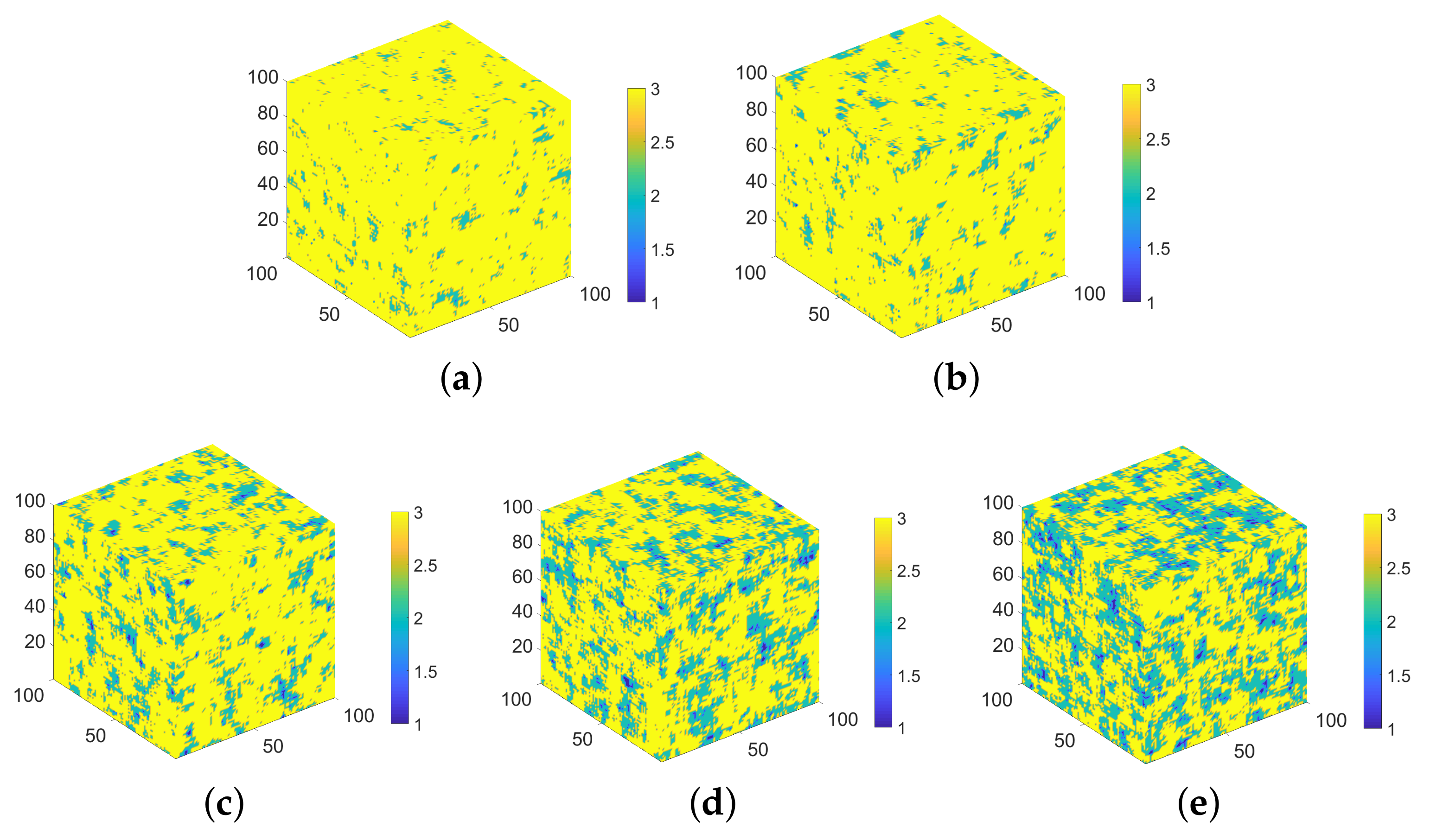


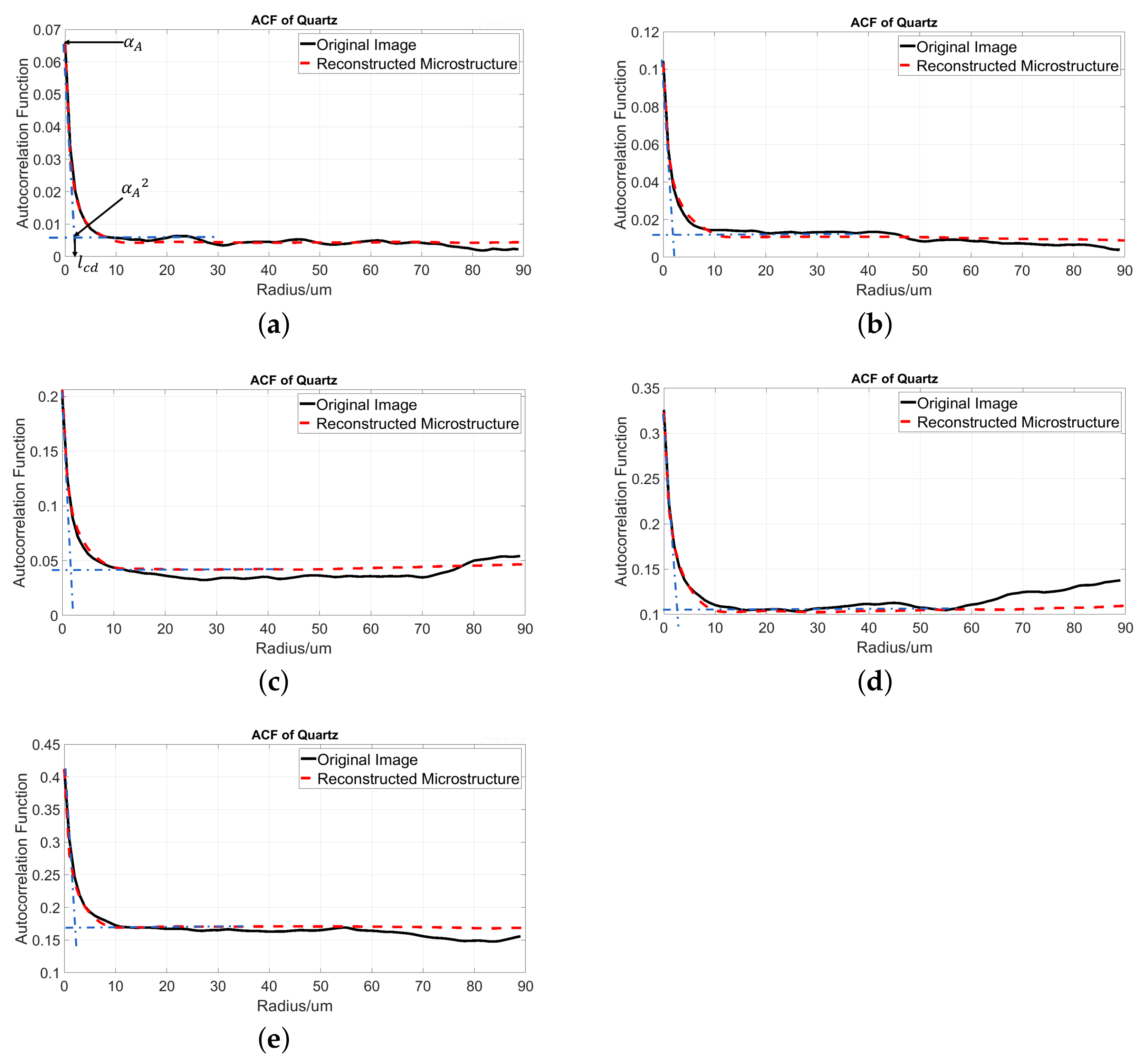
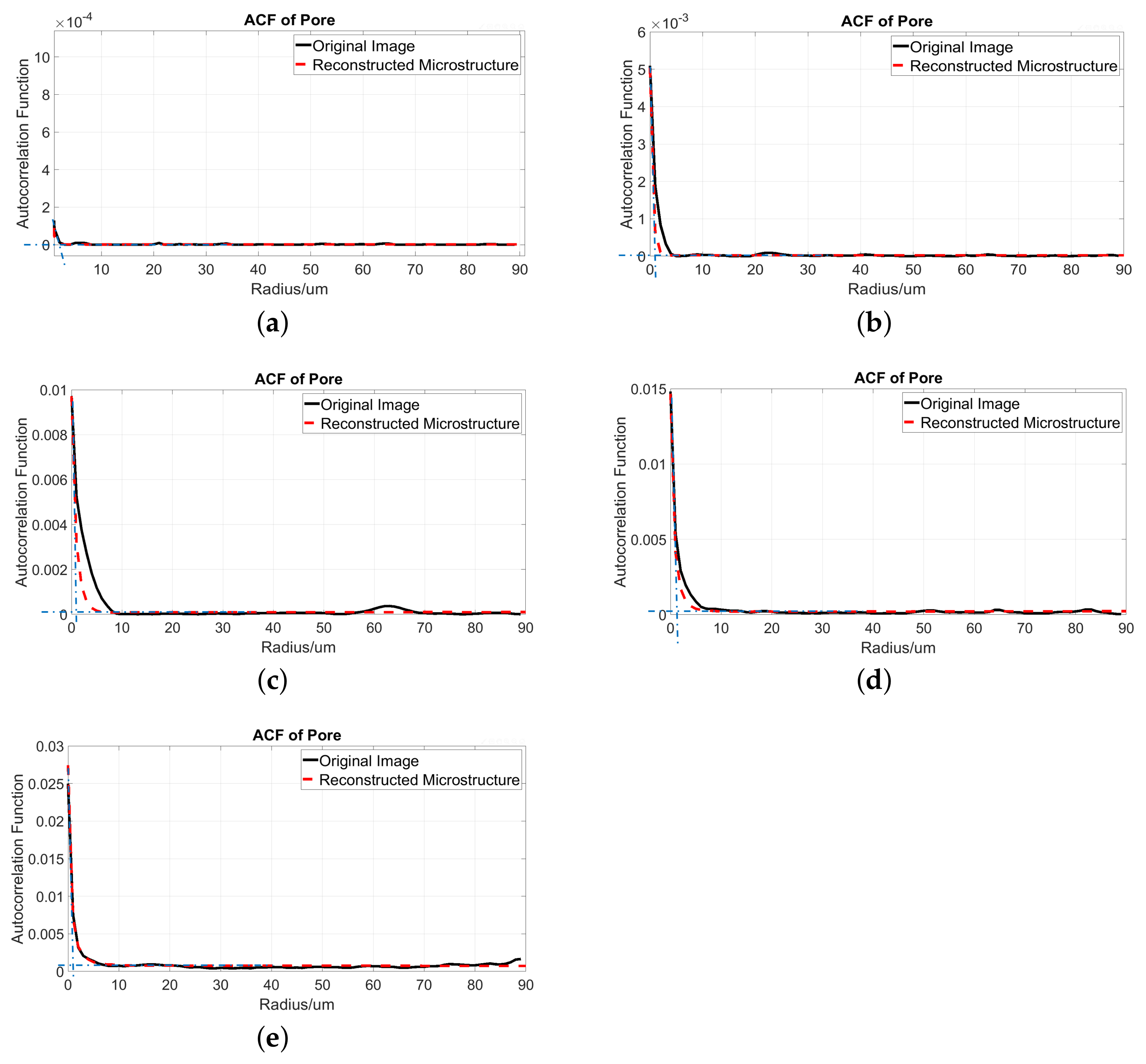
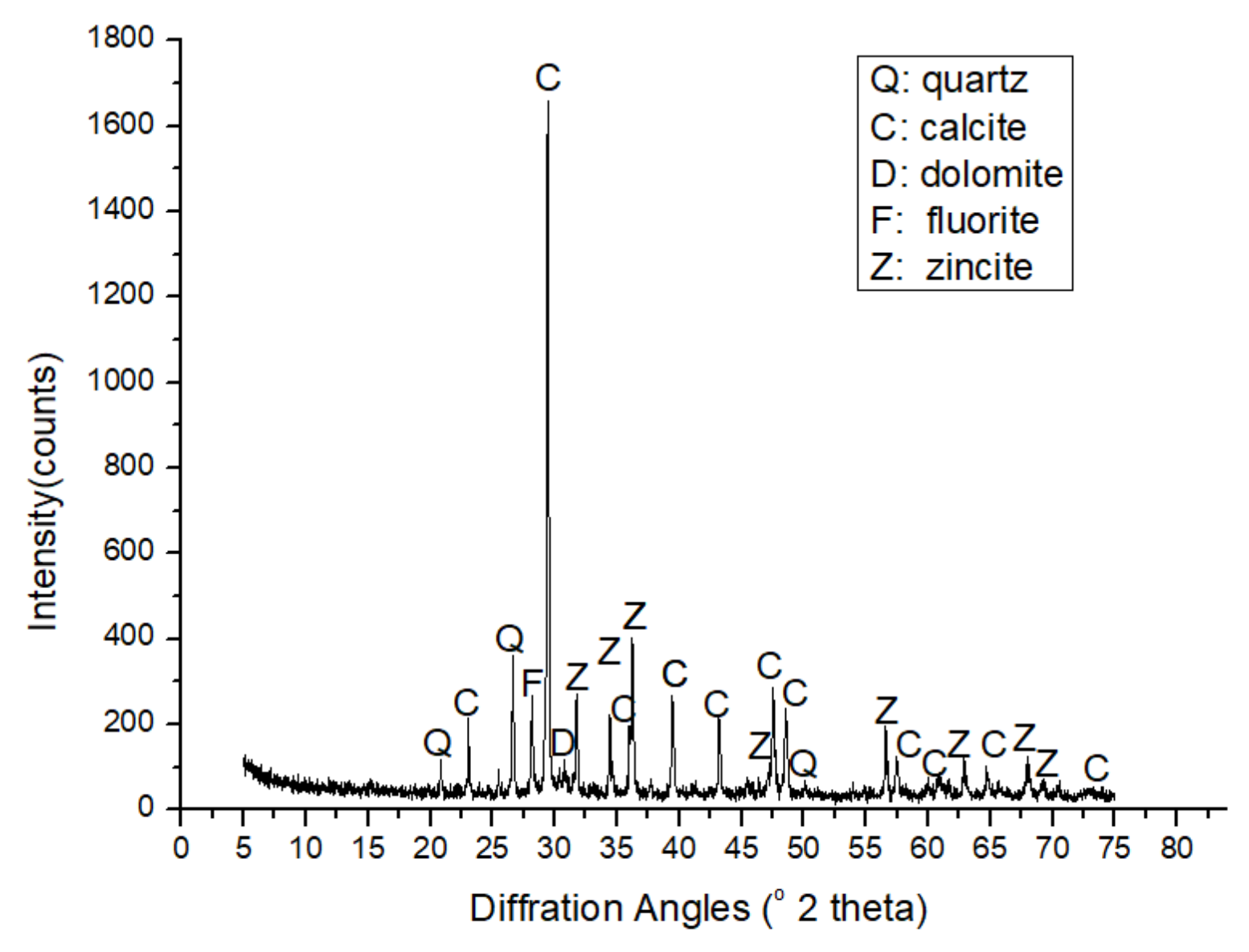
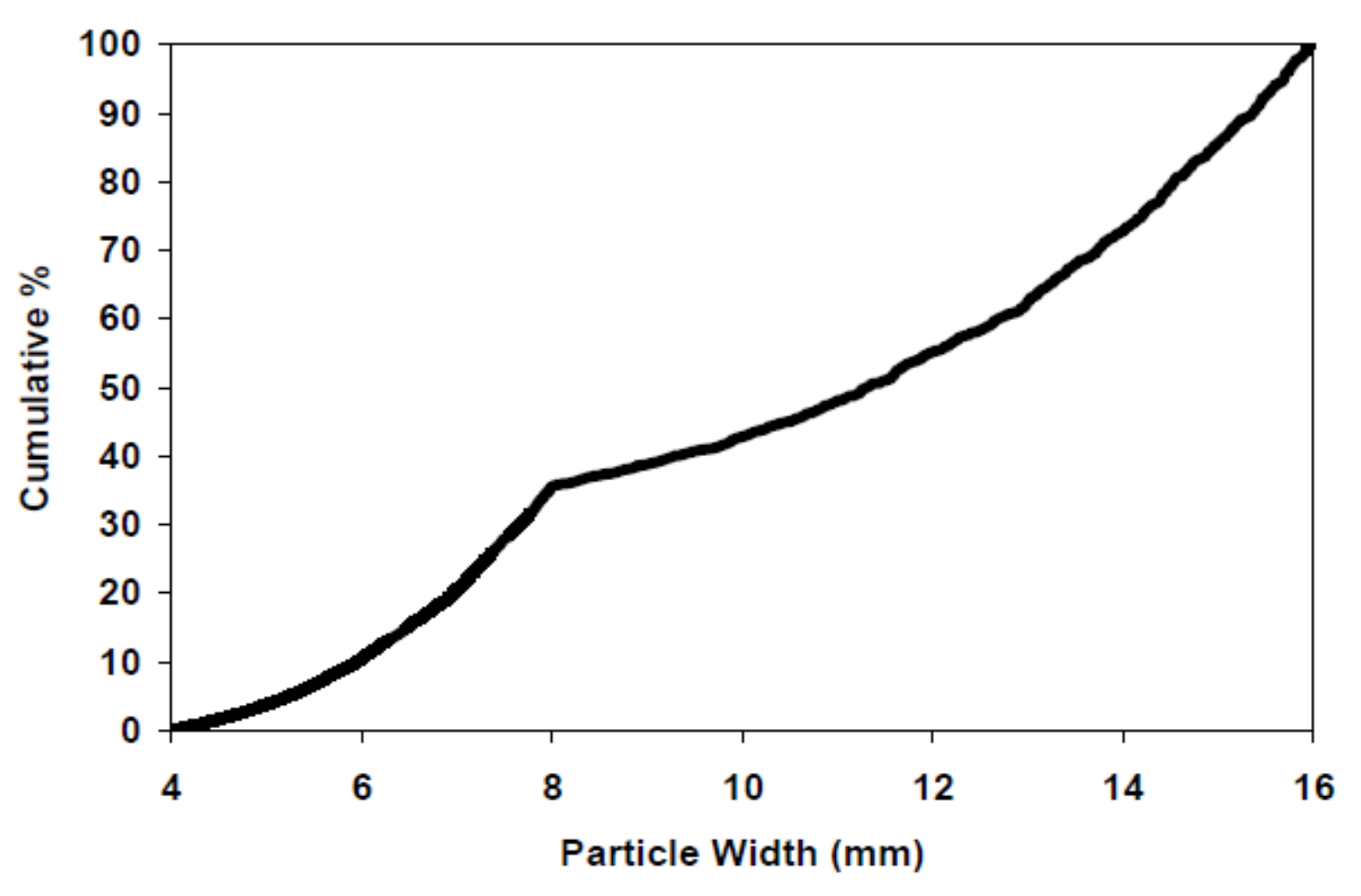


| Properties | The Limestone |
|---|---|
| Surface-dried saturation density (gcm) | 2.69 |
| Oven-dried density (gcm) | 2.67 |
| Bulk density (gcm) | 2.71 |
| Water absorption after 24 h (%) | 0.51 |
| Specific gravity | 2.69 |
| Phases | Data Resources | Mean Fraction , % | Median Fraction , % | Mode Fraction , % |
|---|---|---|---|---|
| Pore | Image analysis | 3.94 | 3.41 | 3.60 |
| Fitted lognormal function | 3.76 | 3.32 | 2.58 | |
| Quartz | Image analysis | 19 | 19.27 | 11.4 |
| Fitted lognormal function | 17.03 | 15.05 | 11.35 |
| Calcite, % | Dolomite, % | Fluorite, % | Quartz, % | |||||
|---|---|---|---|---|---|---|---|---|
| Mass | Volume | Mass | Volume | Mass | Volume | Mass | Volume | |
| Sample 1 | 68.60 | 78.26 | 4.19 | 6.84 | 2.46 | 2.54 | 11.36 | 12.37 |
| Sample 2 | 70.66 | 78.34 | 7.13 | 5.53 | 2.40 | 2.44 | 10.80 | 13.69 |
| Sample 3 | 71.13 | 79.51 | 5.8 | 4.19 | 3.32 | 2.71 | 12.02 | 13.58 |
| Average 1 | 70.13 | 78.70 | 5.71 | 5.52 | 2.39 | 2.56 | 11.39 | 13.21 |
| Average 2 | 86.79 | 13.21 | ||||||
| Microstructure ID | Pore & Quartz Fraction, % | Volume Fraction , % | Cube Pore Fraction , % | Cube Quartz Fraction , % | Cube Others Fraction , % |
|---|---|---|---|---|---|
| 1 | (0.11 6.48) | 1.65 | 0.65 | 13.93 | 85.43 |
| 2 | (0.51 10.41) | 20.33 | |||
| 3 | (0.83 20.51) | 6.05 | |||
| 4 | (1.45 32.42) | 1.24 | |||
| 5 | (2.77 40.91) | 0.78 |
| Sample ID | Total Pore Fraction, % | Pore Fraction over 1 m, % |
|---|---|---|
| 1 | 0.23 | 0.17 |
| 2 | 0.55 | 0.49 |
| 3 | 0.37 | 0.37 |
| 4 | 0.79 | 0.79 |
| 5 | 0.25 | 0.09 |
| 6 | 2.56 | 2.35 |
| Average | 0.8 | 0.7 |
Publisher’s Note: MDPI stays neutral with regard to jurisdictional claims in published maps and institutional affiliations. |
© 2021 by the authors. Licensee MDPI, Basel, Switzerland. This article is an open access article distributed under the terms and conditions of the Creative Commons Attribution (CC BY) license (https://creativecommons.org/licenses/by/4.0/).
Share and Cite
Qiu, X.; Chen, J.; Deprez, M.; Cnudde, V.; Ye, G.; De Schutter, G. 3D Microstructure Simulation of Reactive Aggregate in Concrete from 2D Images as the Basis for ASR Simulation. Materials 2021, 14, 2908. https://doi.org/10.3390/ma14112908
Qiu X, Chen J, Deprez M, Cnudde V, Ye G, De Schutter G. 3D Microstructure Simulation of Reactive Aggregate in Concrete from 2D Images as the Basis for ASR Simulation. Materials. 2021; 14(11):2908. https://doi.org/10.3390/ma14112908
Chicago/Turabian StyleQiu, Xiujiao, Jiayi Chen, Maxim Deprez, Veerle Cnudde, Guang Ye, and Geert De Schutter. 2021. "3D Microstructure Simulation of Reactive Aggregate in Concrete from 2D Images as the Basis for ASR Simulation" Materials 14, no. 11: 2908. https://doi.org/10.3390/ma14112908






